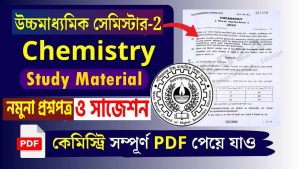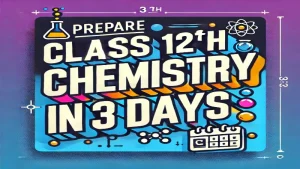1.The number of octahedral void(s) per atom present in a cubic close-packed structure is [CBSE AIPMT 2012]
A. 2
B. 4
C. 1
D. 3
2.A metal crystallizes with a face-centered cubic lattice. The edge of the unit cell is 408 pm. The diameter of the metal atom is [CBSE AIPMT 2012]
A.144 pm
B.204 pm
C.288 pm
D.408 pm
3.AB crystallizes in a body centred cubic lattice with edge length ‘a’ equal to 387 pm. The distance between two oppositively charged ions in the lattice is [CBSE AIPMT 2010]
A. 300 pm
B. 335 pm
C. 250 pm
D. 200 pm
4.If ‘a’ stands for the edge length of the cubic systems: simple cubic, body centred cubic and face centred cubic, then the ratio of the radii of the spheres in these systems will be respectively: [CBSE AIPMT 2008]
A.(1/2):(√3/4):(1/2√2)
B.
C.
D.
5.Percentage of free space in a body centred cubic unit cell is [CBSE AIPMT 2008]
A.32%
B.34%
C.28 %
D.20%
6.The fraction of total volume occupied by the atoms present in a simple cube is [CBSE AIPMT 2007]
A.π/3√2
B.π/4√2
C.π/4
D.π/6
7.If NaCl is doped with 10–4 mol % of Sr Cl2, the concentration of cation vacancies will be (NA = 6.02 × 1023 mol–1) [CBSE AIPMT 2007]
A.6.022× 10^17 mol^-1
B.
C.
D.
8. The appearance of colour in solid alkali metal halides is generally due to [CBSE AIPMT 2006]
A. Schottky defect
B. Frenkel defect
C. Interstitial position
D. F Centre (anion vaxancies)
9. In a face-centered cubic lattice, a unit cell is shared equally by how many unit cells? [CBSE AIPMT 2005]
A.2
B.4
C.6
D.8
10.A compound formed by elements X and Y crystallizes in a cubic structure in which atoms X are at the corners of the cube and atoms Y are at the face-centers. The formula of the compound is [CBSE AIPMT 2004]
A.XY3
B.X3Y
C.XY2
D.XY
11.In a compound, atoms of element Y form ccp lattice and those of element X occupy 2/3 rd of tetrahedral voids. The formula of the compound will be [AIEEE 2008]
A.X3Y4
B.X4Y3
C.X2Y3
D.X2Y
12.Total volume of atoms present in face-centred cubic unit cell of metal is (r is atomic radius) [AIEEE 2006]
A. (16/3)πr^3
B. (24/3)πr^3
C. (12/3)πr^3
D. (20/3)πr^3
13.An ionic compound has a unit cell consisting of A ions at the corners of a cube and B ions on the centres of faces of the cube. The empirical formula of the compound would be [AIEEE 2005]
A. AB
B. A2B
C. AB3
D. A3B
14.How many unit cells are present in a cube-shaped ideal crystal of NaCl of mass 1.0 g? [AIEEE 2003]
A. 5.14 × 10^21 unit cells
B. 1.28 × 10^21 unit cells
C. 5.14 × 10^20 unit cells
D. 2.57 × 10^21 unit cells
15.Which of the following is a molecular crystal? [KARNATAKA CET 2010]
A. Dry ice
B. Quartz
C. Rock salt
D. Diamond
16.The edge length of a face centred cubic cell of an ionic substance is 508 pm. If the radius of the cation is 110 pm, the radius of the anion is [AIEEE 2010]
A. 288 pm
B.144 pm
C. 6118 pm
D. 398 pm
17.Sodium chloride, NaCl usually crystallizes in a face centred cubic lattice. How many ions are in contact with any single Na+ ion? [DELHI PMT 2010]
A.8
B.6
C.4
D.1
18.Percentage of free space in cubic close packed structure and in body centred packed structure are respectively [AIEEE 2010]
A. 30 and 26%
B. 26 and 32 %
C. 32 and 48 %
D. 26 and 32 %
19.AB crystallizes in a body centred cubic lattice with edge length ‘a’ equal to 387 pm. The distance between two oppositively charged ions in the lattice is [CBSE AIPMT 2010]
A. 200 pm
B. 300 pm
C. 335 pm
D.250 pm
20.A compound contains two types of atoms X and Y. It crystallizes in a cubic lattice with atoms X at the corners of the unit cell and atoms Y at the body centre. The simplest possible formula of this compound is: [DELHI PMT 2009]
A. X8Y
B.X2Y
C.XY
D.XY8
21.A compound of ‘A’ and ‘B’ crystallizes in a cubic lattice in which the ‘A’ atoms occupy the lattice points at the corners of the cube. The ‘B’ atoms occupy the centre of each face of the cube. The probable empirical formula of the compound is [KARNATAKA CET 2009]
A. AB3
B. AB
C. A3B
D. AB2
22. Lithium metal crystallises in a body centred cubic crystal. If the length of the side of the unit cell of lithium is 351 pm, the atomic radius of the lithium will be: [CBSE AIPMT 2009]
A. 300.5 pm
B. 75.5 pm
C. 151.8 pm
D. 240.8 pm
23. Copper crystallises in a face-centred cubic lattice with a unit cell length of 361 pm. What is the radius of copper atom in pm? [CBSE AIPMT 2009] & [AIEEE 2009]
A. 108 pm
B. 181 pm
C. 157 pm
D. 128 pm
24. A compound is formed by elements A and B. This crystallizes in the cubic structure where A atoms are at the corners of the cube and B atoms are at the body centres. The simplest formula of the compound is [KARNATAKA CET 2008]
A. AB
B. AB6
C. A6B
D. A8B4
25.An ionic compound is expected to have tetrahedral structure if r+/r- lies in the range of [KARNATAKA CET 2008]
A. 0.414 to 0.732
B. 0.732 to 1
C. 0.155 to 0.225
D. 0.225 to 0.414
26.In which of the following crystals alternate tetrahedral voids are occupied? [IIT-JEE 2005]
A. NaCl
B. ZnS
C. CaF2
D. Na2O
27. A metal has a fcc lattice. The edge length of the unit cell is 404 pm. The density of the metal is 2.72 g cm–3. The molar mass of the metal is
(NA Avogadro’s constant = 6.02 × 1023 mol–1) [NEET 2013]
A. 40
B. 30
C. 27 g/mol
D. 20
28. The number of carbon atoms per unit cell of diamond unit cell is [NEET 2013]
A. 8
B. 6
C. 4
D. 2
29.
solid state drives objective type questions with answers, solid state mcq with solutions, solid state question bank with answers, solid state chemistry important questions with answers hsc
Solid State SET PET previous year question
A match box exhibits [MP-PET=1993 & 95]
- Cubic geometry
- Monoclinic geometry
- Orthorhombic geometry
- Tetragonal geometry
Silicon is found in nature in the form of [MH-CET=2002]
- Body centered cubic structure
- Hexagonal close-packed structure
- Network solid
- Face centered cubic structure
For some crystals, the radius ratio for cation and anion is 0.525, its coordination number will be[MH-CET=2003]
- 2
- 4
- 6
- 8
Which of the following is a three dimensional silicate [MH-CET=2003]
- Mica
- Spodumene
- Zeolite
- None of these
Which defect causes decrease in the density of crystal [KCET=2000 & 05]
- Frenkel
- Schottky
- Interstitial
- F−centre
Doping of silicon (Si) with boron B leads to [UPSEAT=2004]
- n-type semiconductor
- p-type semiconductor
- Metal
- Insulator
Frenkel defect is caused due to [MP-PET=1994]
- An ion missing from the normal lattice site creating a vacancy
- An extra positive ion occupying an interstitial position in the lattice
- An extra negative ion occupying an interstitial position in the lattice
- The shift of a positive ion from its normal lattice site to an interstitial site
The following is not a function of an impurity present in a crystal [MP-PET=1995]
- Establishing thermal equilibrium
- Having tendency to diffuse
- Contributing to scattering
- Introducing new electronic energy levels
Due to Frenkel defect, the density of ionic solids [MP-PET=1996; MP-PMT=2002]
- Increases
- Decreases
- Does not change
- Changes
Schottky defect in crystals is observed when [CBSE PMT 1998; KCET 2002]
- Density of crystal is increased
- Unequal number of cations and anions are missing from the lattice
- An ion leaves its normal site and occupies an interstitial site
- Equal number of cations and anions are missing from the lattice
———————————-
Solid State CBSE Previous Year Question Papers
1.In solid CsCl each Cl is closely packed with how many Cs [MP PET 2003]
- A) 8
- B) 6
- C) 10
- D) 2
2. In A+B− ionic compound, radii of A+ and B− ions are 180pm and 187pm respectively. The crystal structure of this compound will be
- A) NaCl type
- B) CsCl type
- C) ZnS type
- D) Similar to diamond
3.In which of the following substances the carbon atom is arranged in a regular tetrahedral structure [NCERT 1978]
- A) Diamond
- B) Benzene
- C) Graphite
- D) Carbon black
4. The coordination number of a metal crystallizing in a hexagonal close packed structure is [NCERT 1978; IIT 1999]
- A) 4
- B) 12
- C) 8
- D) 6
5.How many chloride ions are there around sodium ion in sodium chloride crystal [NCERT 1979, 80; CPMT 1988; BHU 1982, 87; MP PET 1995, 99 ; CBSE PMT 2004]
- A) 3
- B) 8
- C) 4
- D) 6
6.An example of a non-stoichiometric compound is [NCERT 1983]
- A) Al2O3
- B) Fe3O4
- C) NiO2
- D) PbO
7.Crystal structure of NaCl is [NCERT 1982; BHU 1995]
- A) fcc
- B) bcc
- C) Both A and B
- D) None
8.The number of Cl− ions around one Na+ in NaCl crystal lattice is [MP PET 1996; BVP 2004]
- A) 12
- B) 4
- C) 8
- D) 6
9.In the calcium fluoride structure the co-ordination number of the cation and anions are respectively [J & K 2005]
- A) 6, 6
- B) 8, 4
- C) 4, 4
- D) 4, 8
10.In a face centred cubic cell, an atom at the face contributes to the unit cell [Karnataka (Engg./Med.) 2000; AFMC 2001]
- A) 1/4 part
- B) 1/8 part
- C) 1 part
- D) 1/2 part
MCQs Solution
1.Correct Answer: A Solution : In Cs+ Cl− crystal co-ordination number of each ion is 8.
2.Correct Answer: B Solution : r+/r−=(180/187)=0.962 which lies in the range of 0.732 to 1.000 , hence co-ordination number = 8 i.e. the structure is CsCl type.
3.Correct Answer: A Solution : In diamond, C-atoms are arranged in a regular tetrahedral structure
4.Correct Answer: B Solution : In hcp, co-ordination no. is 12.
5.Correct Answer: D Solution : In NaCl crystal every Na+ ion is surrounded by 6 Cl− ion and every chloride ion is surrounded by 6 Na+ ion.
6. Correct Answer: B Solution : Fe3O4 is a non-stoichiometric compound because in it the ratio of the cations to the anions becomes different from that indicated by the chemical formula.
7. Correct Answer: A Solution : NaCl has fcc arrangement of ions.
8 Correct Answer: D Solution : In NaCl crystal every Na+ ion is surrounded by 6 Cl− ion and every chloride ion is surrounded by 6 Na+ ion.
9.Correct Answer: B Solution : The Ca2+ ions are arranged in (ccp) arrangement, i.e. Ca2+ ions are present at all corners and tat the center of each face of the cube. the fluoride ions occupy all the tetrahedral sites. This is 8 : 4 arrangement i.e., each Ca2+ ion is surrounded by 8F− ions and each F− ion by four Ca2+ ions)
10. Correct Answer: D
——————————————–
Solid State MCQ Practice Questions
- Which of the following conditions favours the existence of a substance in the solid state?
(i) High temperature
(ii) Low temperature
(iii) High thermal energy
(iv) Weak cohesive forces - Which of the following is not a characteristic of a crystalline solid?
(i) De nite and characteristic heat of fusion.
(ii) Isotropic nature.
(iii) A regular periodically repeated pattern of arrangement of constituent particles in the entire crystal.
(iv) A true solid - Which of the following is an amorphous solid?
(i) Graphite (C)
(ii) Quartz glass (SiO2)
(iii) Chrome alum
(iv) Silicon carbide (SiC) - The sharp melting point of crystalline solids is due to .
(i) a regular arrangement of constituent particles observed over a short distance in the crystal lattice.
(ii) a regular arrangement of constituent particles observed over a long distance in the crystal lattice.
(iii) same arrangement of constituent particles in different directions.
(iv) different arrangement of constituent particles in different directions. - Iodine molecules are held in the crystals lattice by .
(i) london forces
(ii) dipole-dipole interactions
(iii) covalent bonds
(iv) coulombic forces - Which of the following is a network solid?(i) SO2 (Solid)
(ii) I2
(iii) Diamond
(iv) H2O (Ice) - Which of the following is not the characteristic of ionic solids?
(i) Very low value of electrical conductivity in the molten state.
(ii) Brittle nature.
(iii) Very strong forces of interactions.
(iv) Anisotropic nature. - Graphite is a good conductor of electricity due to the presence of .
(i) lone pair of electrons
(ii) free valence electrons
(iii) cations
(iv) anions - Which of the following arrangements shows schematic alignment of magnetic moments of antiferromagnetic substances? (i) ↑ ↑ ↑ ↑ ↑ ↑ (ii) ↓ ↓ ↓ ↓ ↓ ↓ (iii) ↑ ↑ ↓ ↑ ↑ ↓ (iv) ↑ ↓ ↑ ↓ ↑ ↓
- Which of the following is true about the value of refractive index of quartz glass? (i) Same in all directions (ii) Different in different directions (iii) Cannot be measured (iv) Always zero
- The lattice site in a pure crystal cannot be occupied by . (i) molecule (ii) ion (iii) electron (iv) atom
- Graphite cannot be classified as . (i) conducting solid (ii) network solid (iii) covalent solid (iv) ionic solid
- Potassium crystallizes in a bcc lattice, hence the coordination number of potassium in potassium metal is [KCEE=1993] (A) 0 (B) 4 (C) 6 (D) 8
- In the crystal of CsCl, the nearest neighbours of each Cs ion are [MP PET 1993] A) Six chloride ions B) Eight chloride ions C) Six Cs ions D) Eight Cs ions
- Which of the following statements is not true about NaCl structure [DCE 2001] A) Cl− ions are in fcc arrangement B) Na+ ions has coordination number 4 C) Cl− ions has coordination number 6 D) Each unit cell contains 4NaCl molecules







